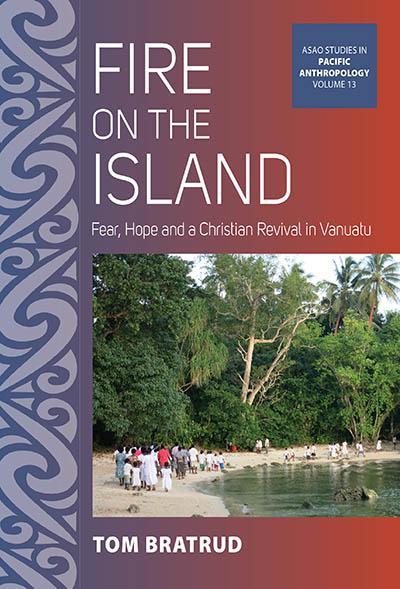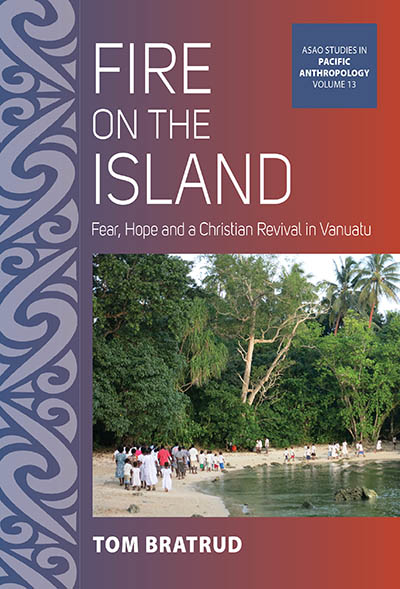By TOM BRATRUD

Since Fire on the Island was one of our most popular and well-received titles in 2022, we are delighted that its author Tom Bratrud has kindly contributed this exclusive article describing his fieldwork, events on the island, and the aims of his book.
Many anthropologists have experiences during fieldwork that challenge not only their initial research plan but also their understanding of the world. In the book Fire on the Island: Fear, Hope and a Christian Revival in Vanuatu, I discuss how an astonishing child-led Christian revival movement aimed to change society in Vanuatu in the South Pacific from 2014 onwards—but also had its effects on me as an anthropologist following the movement.
Fire on the Island builds on my ethnographic material of the revival movement as it developed on Ahamb Island in Northern Vanuatu during my fieldwork there in 2014 and 2017. The revival developed in the wake of enduring political disputes in the area and gained followers as a framework for turning society away from conflict and wrongdoings to moral renewal and peace. The revival had a dramatic turn after nine months of ‘spiritual war’ between the community and sorcerers who operated in the invisible spiritual realm. At a point of heightened panic, two men thought to be sorcerers and responsible for most of the community’s problems were killed by an anxious and furious mob. This was a difficult event for many, including myself, as I knew and worked with both the killers and the killed and their families.
Based on the revival process, the book’s theoretical concern turned into how in contexts of insecurity and upheaval, fear and hope are powerful sentiments working together to become a potent driving force for change, but where outcomes may easily escape people’s control. In the book, I am also sharing some of my own extraordinary experiences during the revival that could not be easily represented by my own mode of thought and anthropological toolkit. These are experiences that I for the sake of convenience could easily ignore and repress in my analyses of the events. However, I felt it important to include them to show how I, as a visiting ethnographer committed to ‘rational’ scholarly investigations, could also be affected by the transcendent events that had such an impact on my interlocutors.
Before embarking on my fieldwork on Ahamb in 2014, the second of three fieldworks between 2010-2017, I could not have imagined myself writing this book. I was originally interested in other aspects of the life of my Ahamb interlocutors, mainly how it is to live on a small environmentally vulnerable island that cannot sustain its growing population. However, as an anthropology student in Oslo, I learned that fieldwork often necessitates throwing one’s preconceived plans and ideas overboard. What matters is following one’s interlocutors in what they are engaged in and care about. That is core in the deductive method of anthropology, developed by Franz Boas and others, that attempts to correct a fundamental problem in anthropology: the goal of the anthropologist is to help understand human societies, but how can we do this if the researcher is influenced by one’s own preconceived notions concerning the society one is studying?
All my three fieldworks on Ahamb, in 2010, 2014 and 2017 respectively, have had elements of thematical U-turns. However, the fieldwork in 2014 that coincided with the revival entailed the most dramatic one, which felt necessary given the significance of the events for my interlocutors. For instance, while sitting in an interlocutor’s house discussing custom stories about reciprocity, we could be interrupted by crying children coming to tell us that sorcerers had landed in a tree outside the house with the aim to kill someone, which made most community members stay up all night to keep one another safe. Or, after having a dream, a land holder who had previously insisted on the importance of land ownership could announce that he would give a piece of land to his neighbour. Or yet again, after some weeks of spiritual experiences during the revival, women who are not normally allowed to speak in public were suddenly speaking up against chiefs in community meetings and helped change policies for drinking on the island.
In the book, I show how in trying to understand what the revival was and how it impacted people’s thinking, decisions and relationships, I allowed myself to be caught up in the events and follow interlocutors in arenas that became significant to them. This included observing and participating in prayer sessions of healing and the neutralisation of sorcery, also against the effects of sorcery aimed at myself.
While the ethnography of the revival events is useful in itself, it represents only snapshots of Ahamb life. Similarly, my three fieldwork periods on the island are just snapshots from the continuum that make up my islander interlocutors’ lives. In the book, I therefore aim to analyse the revival as part of a greater continuum, spanning over a century but focused on three decades, from 1990-2021. The book thus seeks to understand the revival by paying necessary attention to the historical, local, regional and global context within which it developed. Working theoretically on the fear/hope model also made me look to a variety of social movements globally for comparison, from millennial movements and so-called ‘cargo cults’ to political movements on the political right and left, including Make-America-Great-Againism, European nativism and climate change activism. To make sense of the tragic mystery during the revival—namely how a group of people who normally insist that murder is the greatest of sin and the opposite of love could murder in the name of love to end the flourishing of sin – I found much help in historical theorising of religious violence, including René Girard’s work on the sacrifice of scapegoats which symbolically and efficiently breaks with the previous order so one can start anew.
With the book, I hope to contribute to the understanding of how social upheavals like the revival may emerge, and how renewal movements globally are venues in which social problems may be addressed and sometimes resolved, but simultaneously carry risks of exacerbating those very same problems. I argue that approaching these issues as a researcher necessitates an open-ended frame for investigating not only what people find to be good, but also what they find to threaten this good in different contexts. For me, as described in the book, this process entailed being confronted with my own puzzlement, wonder and vulnerability when resisting the urge to form quick conclusions and explanations to incidents I could not readily understand.
TOM BRATRUD is Postdoctoral Fellow at the Department of Social Anthropology, University of Oslo. He has conducted research in Vanuatu for over ten years and published articles on religion, politics and social life in various journals, including Journal of the Royal Anthropological Institute and Ethnos.

FIRE ON THE ISLAND
Fear, Hope and a Christian Revival in Vanuatu
276pp, 20 illus.; April 2022
$34.95/£27.95 eBook
$135/£99 Hardback
Fire on the Island is published in the ASAO Studies in Pacific Anthropology series. Find more about it here https://www.berghahnbooks.com/series/asao
For the latest news on our books and journals please sign up for our email newsletters.
